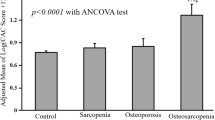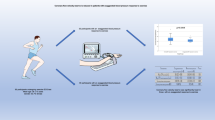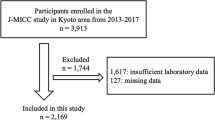Abstract
Reduced skeletal muscle mass is the most important component of sarcopenia. Aging and chronic diseases, including chronic heart failure, are the causes of reduced skeletal muscle mass. However, little is known about the mechanism of skeletal muscle mass reduction in patients with cardiovascular disease (CVD). The purpose of this study was to assess the associations among skeletal muscle mass reduction, endothelial function, and other markers of advanced vascular damage in CVD patients. This was a retrospective cross-sectional analysis that included 310 inpatients with CVD in our hospital. Flow-mediated vasodilation (FMD) was performed to assess early vascular damage, i.e., endothelial dysfunction. The arterial velocity pulse index (AVI) and arterial pressure volume index (API) were assessed to reveal signs of advanced vascular damage, such as arterial stiffening and increased peripheral resistance. The bioelectrical phase angle (PA), as a marker of tissue damage, and the skeletal muscle index (SMI) were measured. Correlation analyses were performed among these parameters. Sarcopenia was diagnosed in 25.5% of patients according to the Asian Working Group for Sarcopenia criteria. Greater progression of arterial stiffness, shown by a higher AVI, and more severe tissue damage, shown by a narrower PA, were found in individuals with sarcopenia. Stepwise multivariate regression analysis showed that sex, age, PA, hypertension, and AVI were factors independently correlated with SMI. In conclusion, advanced vascular damage, such as increased arterial stiffness and peripheral resistance, might play an important role in the reduction in skeletal muscle mass, possibly through damage to skeletal muscle tissue in CVD patients.
This is a preview of subscription content, access via your institution
Access options
Subscribe to this journal
Receive 12 print issues and online access
$259.00 per year
only $21.58 per issue
Buy this article
- Purchase on Springer Link
- Instant access to full article PDF
Prices may be subject to local taxes which are calculated during checkout

Similar content being viewed by others
References
Xue Q-L. The frailty syndrome: definition and natural history. Clin Geriatr Med. 2011;27:1–15. https://doi.org/10.1016/j.cger.2010.08.009.
Cruz-Jentoft AJ, Baeyens JP, Bauer JM, Boirie Y, Cederholm T, Landi F, et al. Sarcopenia: European consensus on definition and diagnosis. Age Ageing. 2010;39:412–23. https://doi.org/10.1093/ageing/afq034.
Harada H, Kai H, Niiyama H, Nishiyama Y, Katoh A, Yoshida N, et al. Effectiveness of cardiac rehabilitation for prevention and treatment of sarcopenia in patients with cardiovascular disease—a retrospective cross-sectional analysis. J Nutr Health Aging. 2017;21:449–56. https://doi.org/10.1007/s12603-016-0743-9.
Harada H, Kai H, Shibata R, Niiyama H, Nishiyama Y, Murohara T, et al. New diagnostic index for sarcopenia in patients with cardiovascular diseases. PLoS ONE. 2017;12:e0178123. https://doi.org/10.1371/journal.pone.0178123.
Ter Avest E, Stalenhoef AF, de Graaf J. What is the role of non-invasive measurements of atherosclerosis in individual cardiovascular risk prediction? Clin Sci. 2007;112:507–16.
Briet M, Boutouyrie P, Laurent S, London GM. Arterial stiffness and pulse pressure in CKD and ESRD. Kidney Int. 2012;82:388–400. https://doi.org/10.1038/ki.2012.131.
Nilsson PM, Boutouyrie P, Cunha P, Kotsis V, Narkiewicz K, Parati G. et al. Early vascular ageing in translation: from laboratory investigations to clinical applications in cardiovascular prevention. J Hypertens. 2013;31:1517–26. https://doi.org/10.1097/HJH.0b013e328361e4bd.
Cunha PG, Cotter J, Oliveira P, Vila I, Boutouyrie P, Laurent S, et al. Pulse wave velocity distribution in a cohort study: from arterial stiffness to early vascular aging. J Hypertens. 2015;33:1438–45. https://doi.org/10.1097/HJH.0000000000000565.
Scuteri A, Tesauro M, Rizza S, Iantorno M, Federici M, Lauro D, et al. Endothelial function and arterial stiffness in normotensive normoglycemic first-degree relatives of diabetic patients are independent of the metabolic syndrome. Nutr Metab Cardiovasc Dis. 2008;18:349–56.
Scuteri A, Morrell CH, Orrù M, Strait JB, Tarasov KV, Ferreli LA. et al. Longitudinal perspective on the conundrum of central arterial stiffness, blood pressure, and aging. Hypertension. 2014;64:1219–27. https://doi.org/10.1161/HYPERTENSIONAHA.114.04127.
Komine H, Asai Y, Yokoi T, Yoshizawa M. Non-invasive assessment of arterial stiffness using oscillometric blood pressure measurement. Biomed Eng Online. 2012;11:6. https://doi.org/10.1186/1475-925X-11-6.
Shisei datum. http://www.shisei-d.co.jp.
Okamoto M, Nakamura F, Musha T, Kobayashi Y. Association between novel arterial stiffness indices and risk factors of cardiovascular disease. BMC Cardiovasc Disord. 2016;16:211–17. https://doi.org/10.1186/s12872-016-0389-x.
Hitsumoto T. Arterial velocity pulse index as a novel marker of atherosclerosis using pulse wave analysis on high sensitivity troponin T in hypertensive patients. Cardiol Res. 2017;8:36–43. https://doi.org/10.14740/cr545w.
Wilhelm-Leen ER, Hall YN, Horwitz RI, Chertow GM. Phase angle, frailty and mortality in older adults. J Gen Intern Med. 2013;29:147–54. https://doi.org/10.1007/s11606-013-2585-z.
Gupta D, Lammersfeld CA, Vashi PG, King J, Dahlk SL, Grutsch JF, et al. Bioelectrical impedance phase angle as a prognostic indicator in breast cancer. BMC Cancer. 2008;8:249–55. https://doi.org/10.1186/1471-2407-8-249.
Gupta D, Lammersfeld CA, Vashi PG, King J, Dahlk SL, Grutsch JF, et al. Bioelectrical impedance phase angle in clinical practice: implications for prognosis in stage IIIB and IV non-small cell lung cancer. BMC Cancer. 2009;9:37–42. https://doi.org/10.1186/1471-2407-9-37.
Gupta D, Lis CG, Dahlk SL, Vashi PG, Grutsch JF, Lammersfeld CA. Bioelectrical impedance phase angle as a prognostic indicator in advanced pancreatic cancer. Br J Nutr. 2004;92:957–62. https://doi.org/10.1079/BJN20041292.
Norman K, Stobaus N, Zocher D, Bosy-Westphal A, Szramek A, Scheufele R, et al. Cutoff percentiles of bioelectrical phase angle predict functionality, quality of life, and mortality in patients with cancer. Am J Clin Nutr. 2010;92:612–19. https://doi.org/10.3945/ajcn.2010.29215.
Chen L-K, Liu L-K, Woo J, Assantachai P, Auyeung TW, Bahyah KS, et al. Sarcopenia in Asia: consensus report of the Asian Working Group for Sarcopenia. JAMDA. 2014;15:95–101. https://doi.org/10.1016/j.jamda.2013.11.025.
Kyle UG, Bosaeus I, De Lorenzo AD, Deurenberg P, Elia M, Manuel Gómez J, et al. Bioelectrical impedance analysis-part II: utilization in clinical practice. Clin Nutr. 2004;23:1430–53. https://doi.org/10.1016/j.clnu.2004.09.012.
Tanimoto Y, Watanabe M, Sun W, Sugiura Y, Tsuda Y, Kimura M, et al. Association between sarcopenia and higher-level functional capacity in daily living in community-dwelling elderly subjects in Japan. Arch Gerontol Geriatrics. 2012;55:e9–13. https://doi.org/10.1016/j.archger.2012.06.015.
Sueta D, Yamamoto E, Tanaka T, Hirata Y, Sakamoto K, Tsujita K, et al. The accuracy of central blood pressure wave form by novel mathematical transformation of non-invasive measurement. Int J Cardiol. 2015;189:244–46. https://doi.org/10.1016/j.ijcard.2015.03.182.
Sasaki-Nakashima R, Kino T, Chen L, Doi H, Minegishi S, Abe K, et al. Successful prediction of cardiovascular risk by new non-invasive vascular indexes using suprasystolic cuff oscillometric waveform analysis. J Cardiol. 2017;69:30–37. https://doi.org/10.1016/j.jjcc.2016.06.004.
Kanahara M, Harada H, Katoh A, Ikeda H. New methodological approach to improve reproducibility of brachial artery flow-mediated dilatation. Echocardiography. 2014;31:197–202. https://doi.org/10.1111/echo.12307.
Quan H, Li B, Couris CM, Fushimi K, Graham P, Hider P, et al. Updating and validating the charlson comorbidity index and score for risk adjustment in hospital discharge abstracts using data from 6 countries. Am J Epidemiol. 2011;173:676–82. https://doi.org/10.1093/aje/kwq433.
Scuteri A, Rovella V, Alunni Fegatelli D, Tesauro M, Gabriele M, Di Daniele N. An operational definition of SHATS (Systemic hemodynamic atherosclerotic syndrome): role of arterial stiffness and blood pressure variability in elderly hypertensive subjects. Int J Cardiol. 2018;263:132–7. https://doi.org/10.1016/j.ijcard.2018.03.117.
Mogi M, Kohara K, Tabara Y, Tsukuda K, Igase M, Horiuchi M. Correlation between the 24-h urinary angiotensinogen or aldosterone level and muscle mass: Japan shimanami health promoting program study. Hypertens Res. 2018;41:326–33. https://doi.org/10.1038/s41440-018-0021-9.
Tabara Y, Igase M, Setoh K, Kawaguchi T, Okada Y, Ohara M, et al. Clinical significance of an elevated ankle-brachial index differs depending on the amount of appendicular muscle mass: the J-SHIPP and Nagahama studies. Hypertens Res. 2018;41:354–62. https://doi.org/10.1038/s41440-018-0020-x.
Yamanashi H, Koyamatsu J, Nagayoshi M, Shimizu Y, Kawashiri SY, Kondo H. Screening validity of arterial pressure-volume index and arterial velocity-pulse index for preclinical atherosclerosis in Japanese community-dwelling adults: the Nagasaki Islands Study. J Atheroscler Thromb. 2018;25:792–8. https://doi.org/10.5551/jat.43125.
Timmerman KL, Volpi E. Endothelial function and the regulation of muscle protein anabolism in older adults. Nutr Metab Cardiovasc Dis. 2013;23:S44–50. https://doi.org/10.1016/j.numecd.2012.03.013.
Scuteri A, Stuehlinger MC, Cooke JP, Wright JG, Lakatta EG, Anderson DE, et al. Nitric oxide inhibition as a mechanism for blood pressure increase during salt loading in normotensive postmenopausal women. J Hypertens. 2003;21:1339–46. https://doi.org/10.1097/01.hjh.0000059082.43904.02.
Scuteri A, Tesauro M, Guglini L, Lauro D, Fini M, Di Daniele N. Aortic stiffness and hypotension episodes are associated with impaired cognitive function in older subjects with subjective complaints of memory loss. Int J Cardiol. 2013;169:371–7. https://doi.org/10.1016/j.ijcard.2013.09.009.
Basile C, Della-Morte D, Cacciatore F, Gargiulo G, Galizia G, Roselli M, et al. Phase angle as bioelectrical marker to identify elderly patients at risk of sarcopenia. Exp Gerontol. 2014;58:43–6. https://doi.org/10.1016/j.exger.2014.07.009.
Rolland Y, Czerwinski S, Abellan Van Kan G, Morley JE, Cesari M, Onder G, et al. Sarcopenia: its assessment, etiology, pathogenesis, consequences and future perspectives. J Nutr Health Aging. 2008;12:433–50.
Demirci MS, Demirci C, Ozdogan O, Kircelli F, Akcicek F, Basci A, et al. Relations between malnutrition–inflammation–atherosclerosis and volume status. The usefulness of bioimpedance analysis in peritoneal dialysis patients. Nephrol Dial Transpl. 2011;26:1708–16. https://doi.org/10.1093/ndt/gfq588.
Ferrucci L, Penninx BW, Volpato S, Harris TB, Bandeen-Roche K, Balfour J, et al. Change in muscle strength explains accelerated decline of physical function in older women with high interleukin-6 serum levels. J Am Geriatr Soc. 2002;50:1947–54.
Moreno-Franco B, Pérez-Tasigchana RF, Lopez-Garcia E, Laclaustra M, Gutierrez-Fisac JL, Rodríguez-Artalejo F, et al. Socioeconomic determinants of sarcopenic obesity and frail obesity in community-dwelling older adults: the Seniors-ENRICA Study. Sci Rep. 2018;8:10760. https://doi.org/10.1038/s41598-018-28982-x.
Batsis JA, Villareal DT. Sarcopenic obesity in older adults: aetiology, epidemiology and treatment strategies. Nat Rev Endocrinol. 2018;14:513–37. https://doi.org/10.1038/s41574-018-0062-9.
Acknowledgements
The authors would like to thank Misako Ando for the assessment of nutritional status and the measurement of the bioelectrical impedance assay and Yuya Tsukada and Michiya Kishimoto for obtaining physical performance data to diagnose sarcopenia.
Funding
Novartis Pharmaceuticals Japan and Daiichi-Sankyo Company Limited provided research grants (HH), but they had no role in the study design, data collection or analysis, decision to publish, or preparation of the manuscript. This study was supported in part by MEXT/JSPS KAKENHI grant #16K09468 (HK).
Author information
Authors and Affiliations
Corresponding author
Ethics declarations
Conflict of interest
The authors declare that they have no conflict of interest.
Additional information
Publisher’s note Springer Nature remains neutral with regard to jurisdictional claims in published maps and institutional affiliations.
Supplementary information
Rights and permissions
About this article
Cite this article
Harada, H., Ikeda, H., Nishiyama, Y. et al. Increased arterial velocity pulse index is an independent factor related to skeletal muscle mass reduction and tissue damage in patients with cardiovascular disease. Hypertens Res 43, 534–542 (2020). https://doi.org/10.1038/s41440-020-0404-6
Received:
Revised:
Accepted:
Published:
Issue Date:
DOI: https://doi.org/10.1038/s41440-020-0404-6
Keywords
This article is cited by
-
Increased arterial pressure volume index and cardiovascular risk score in China
BMC Cardiovascular Disorders (2023)
-
Phase angle of bioimpedance at 50 kHz is associated with cardiovascular diseases: systematic review and meta-analysis
European Journal of Clinical Nutrition (2022)



